U7
1. If the meaning of a word is clear to you, you can
assume that it is also clear to your audience.
2. The denotative meaning of a word includes all the
feelings, associations, and emotions that the word
touches off in different people.
3. The connotative meaning of a word is more
variable,
figurative, and subjective
than
its
denotative meaning.
4. One way to think of a word’s denotative meaning
is as its dictionary definition.
5. A public speaker needs to use big words to impress
the audience.
6. In dealing with technical topics, a speaker has
little choice but to use technical language.
C.Pride and Prejudice
D.Book
10. “Memories are like fingerprints—no two sets are
ever the same” is an example of
A.metaphor
B.simile
C.antithesis
D.personification
11. “The flickering light of the fire revealed the
fearful faces of the campers” is an example
of .
A.metaphor
B.repetition
C.antithesis
D.alliteration
7. Language helps to shape our sense of reality by
12. Language has a rhythm created by the choice and
A.causing events.
B.giving meaning to events.
C.communicating events.
D.mirroring events.
8. As your textbook explains, connotative meaning
gives words their __________ power.
A.logical
B.difinitional
C.emotional
D.ethnical
9. Which of the following words is the most general
and abstract?
A.Writing
B.Novel
arrangement of words.
13. The main reason to use inclusive language in
your speeches is to avoid being accused of political
incorrectness.
14. Using inclusive language is important in public
speaking both as a matter of audience adaptation and
as a matter of accuracy in language.
15. Which of the following is mentioned as a basic
criterion for the effective use of language?
A.Use language appropriately.
B.Use language persuasively.
C.Use language credibly.
D.Use language emphatically.
16. Which of the following are mentioned as
By Hunter
�
guidelines for the use of inclusive language in public
D.manuscript
speaking?
E.vocalized
A.Avoid the generic “he”.
4. When speaking from a manuscript, you should
B.Avoid the use of “man” when referring to both
strive for the same directness and sincerity in your
men and women.
voice as in an extemporaneous speech.
C.Use names that groups use to identify themselves.
5. Speaking from a manuscript requires very little
D.All of the above.
skill.
U8
1. Good speech delivery
A.has a conversational quality
B.does not call attention to itself
C.requires a strong voice
D.all of the above
E.a and b only
6. “Conversational quality” of extemporaneous
speaking means that a speech has been well
rehearsed yet sounds spontaneous to the audience.
7. It is the __________ of your voice that reveals
whether you are asking a question or making a
statement, whether you are being sincere or sarcastic.
A.spontaneity
B.variety
2. When speaking from a manuscript, you should
C.resonance
A.practice aloud to make sure the speech sounds
natural.
B.be certain the final manuscript is legible at a
glance.
C.work on establishing eye contact with the
audience.
D.all of the above.
E.a and b only.
3. A speech that is fully prepared in advance but that
is delivered from a brief set of notes or a speaking
outline is called a(n) __________ speech.
A.extemporaneous
B.declamatory
C.impromptu
D.inflection
E.rate
8. If you hoped to convey to your audience the
excitement of steering a kayak through a river rapids,
you should probably
A.speak at a faster rate
B.use more vocalized pauses.
C.break eye contact with your audience.
D.gesture less frequently.
E.avoid using dialect.
9. Malcolm said “um” or “uh” every time he got to a
new PowerPoint slide in his informative speech. His
instructor told Malcolm to reduce the number of
__________ in his next speech.
By Hunter
�
A.fillers
B.vocal inflections
C.intonations
D.vocalized pauses
E.inflections
D.illustrative gestures
16. Eye contact is important when the speaker faces
a large audience. But it is impossible to make
effective eye contact with a large audience.
17. Decent and controlled body language or gestures
10.Changes in a speaker’s pitch, rate, and volume
will help deliver our message effectively, therefore
are referred to as vocal variety
speakers should have a vast number of graceful
11.Pronunciation is the ability to say a word as
gestures.
indicated in a dictionary, while articulation is the
18. You can only improve your body language when
ability to form individual speech sounds distinctly.
you practice your delivery
in front of your
12.People in the U.S. usually speak at a rate between
classmates or family before you really make a
120 and 150 words per minute.
speech.
13. Nonverbal
communication
includes
a
speaker’s .
A.gestures
B.eye contact
C.rate of speech
D.all of the above
E.a and b only
14. Which of the following is an appropriate posture?
A.Relaxing your shoulders
B.Leaning to one side
C.Rocking back and forth
U 9
1. Research has shown that visual aids can increase
both the clarity and the persuasiveness of a speaker’s
message.
2. If the object you want to speak about is too large,
too small, or unavailable to use as a visual aid, you
have little choice but to change the topic of your
speech.
3. To be effective as visual aids, photographs must
be large enough to be seen easily by everyone in the
D.Turning your back on the audience whilst you
audience.
speak
15. Using three fingers for the number three is an
4. If you were showing statistical trends in a speech,
the best visual aid to use would probably be a pie
example of using _____________.
graph.
A.symbolic gestures
B.descriptive gestures
C.emotional gestures
5. A __________ graph is best suited for showing
changes in statistics over time or space.
A.pie
By Hunter
�
B.line
C.distributive
D.parallel
E.ratio
usually organized in topical order.
4. When dealing with a question of value, a public
speaker needs to justify his or her value judgment on
the basis of some set of standards or criteria.
6. When you finish discussing a PowerPoint slide,
5. According to your textbook, “To persuade my
you should leave it on screen until you get to the next
audience that doctor-assisted suicide is morally
slide.
acceptable” is a specific purpose statement for a
7. It is important to maintain strong eye contact with
persuasive
speech
on
a
question
your audience when you are presenting a visual aid.
of .
8. When you plan to use PowerPoint in your speech,
A.fact
you should always bring a backup copy of your
B.policy
slides on a flash drive.
C.judgment
9. According to your textbook, when making a
D.health
PowerPoint slide, you should try to use at least five
E.value
colors so the slide will be visually appealing.
6. Questions of policy deal with whether something
10.If you were giving a speech about how to execute
should or should not be done.
basic karate moves, the best kind of visual aid to use
7. “To persuade my audience that capital punishment
would probably be .
is unjust” is a specific purpose statement for a
A.yourself
B.a photograph
C.a chart
D.a drawing
E.a painting
U10
1. Persuasion is the process of creating, reinforcing,
or changing people’s beliefs or actions.
2. A persuasive speech on a question of fact is
essentially the same as an informative
3. Persuasive speeches on questions of fact are
persuasive speech on a question of policy.
8. When trying to persuade listeners to take action,
you should usually be specific about the action you
want them to take.
9. Comparative-advantages order is used most often
in organizing persuasive speeches on questions of
value.
10. In a speech seeking to persuade her audience to
support the city’s ban on unlimited drink specials at
local bars, Darlene used examples and statistics to
demonstrate the seriousness of binge drinking as a
problem on college campuses. Which of the three
By Hunter
�
basic issues of persuasive speeches on questions of
D.hypothetical example
policy did Darlene address in this part of her speech?
E.simile
A.need
B.fact
C.action
D.value
E.plan
16.A persuasive speaker who argues that capital
punishment should be outlawed because it violates
the constitutional principle banning cruel and
unusual punishment is reasoning from specific
instances.
11.One way to establish your credibility in a speech
17. The following is an example of reasoning from
introduction is to let the audience know the source
principle: “Places such as Singapore that allow
of your expertise.
caning and other forms of corporal punishment have
12. Establishing common ground with an audience
exceedingly low crime rates. If caning were used in
is especially important in the conclusion of a
the United States, the U.S. would have lower crime
persuasive speech.
rates as well.”
13. An advantage of using statistics in your speech
18. The following statement is an example of
is that numbers speak for themselves.
reasoning from analogy: “If you can make great
14. Extended examples can be used either one at a
tacos, you can make great enchiladas.”
time to illustrate a point or piled one upon
19. The strongest source of emotional appeal in a
another to create an impression.
persuasive speech is the sincerity and conviction of
15.Alisha began the introduction of her speech by
the speaker.
saying: Have you ever been knocked down so hard
When you reason from specific instances in a
by life that you didn’t feel you’d ever get back up?
persuasive speech, you should
This has happened to me many times, the first being
A.reinforce your argument with statistics and
when I tried to ride a bicycle when I was very young.
testimony.
Today I want to discuss with you some basic
B.include at least one extended example among your
strategies for coping with life’s challenges. What
specific instances.
kind of supporting material did Alisha use in her
C.avoid drawing conclusions from too few instances.
introduction?
A.expert testimony
B.brief example
C.metaphor
D.all of the above.
E.a and c only.
20.Hasty generalization is a fallacy in reasoning
from principle.
By Hunter
�
21. False cause, or post hoc ergo propter hoc, is an
2. The speaker in the prepared speech should focuse
error in reasoning in which a speaker mistakenly
on a limited number of main points.
assumes that because one event follows another, the
3. Beyond basic principles, the most important
first event is the cause of the second.
element of a successful prepared speech is creativity.
22. To say that analogical cases must be essentially
4.In English speaking competitions, the speaker will
alike means that they must be similar enough that
get the impropmtu speech topic one day in advance
what is true of one is also true of the other.
for sound preparation.
23. The bandwagon fallacy assumes that because
5. Once the speakers are onstage, they deliver the
something is popular, it is therefore good, correct, or
prepared speech and leave the stage to prepare for
desirable.
improptu speeches.
24.What error in reasoning is exemplified by the
6. Speaking at a normal pace will help you to calm
following statement? My Volkswagen constantly
down and help the judges to hear you more clearly.
needs repairs, and so does my roommate’s Toyota.
7. To be an excellent impromptu speaker, you should
We can see, then, that foreign cars are unreliable.
have a fund of knowledge.
8. To impress the judges in the Q&A, the speaker can
use a long story, a detailed account of personal
experience, or even a difficult and long quotation to
show off your knowledge.
9. If you are given the questions for which you have
prepared in advance, recite an answer you have
worked out ahead of time.
10.When you practice the Q&A, listen to the
questions and answer them concisely within the one-
minute time limit.
A.invalid analogy
B.hasty generalization
C.circular thinking
D.false cause
E.faulty deduction
U11
1. A speech that gives thanks for a gift or an award
is called a(n) acceptance speech.
2. Bill Clinton’s speech dedicating the Monument to
the Struggle against World Terrorism at the site of
the 9/11 attack in New York City is an example of
a(n) commemorative speech.
U12
1.The topics for prepared speech are mainly about
campus issues.
By Hunter
�
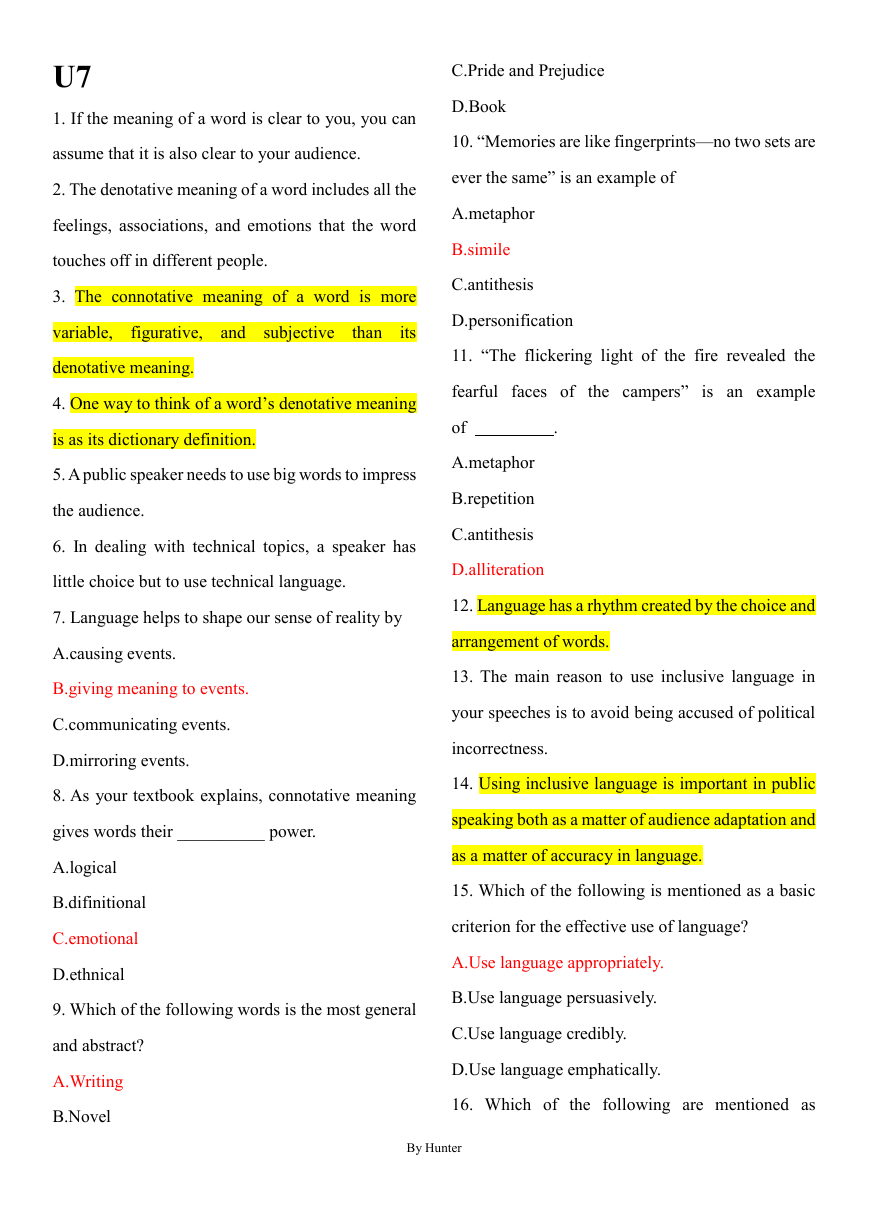
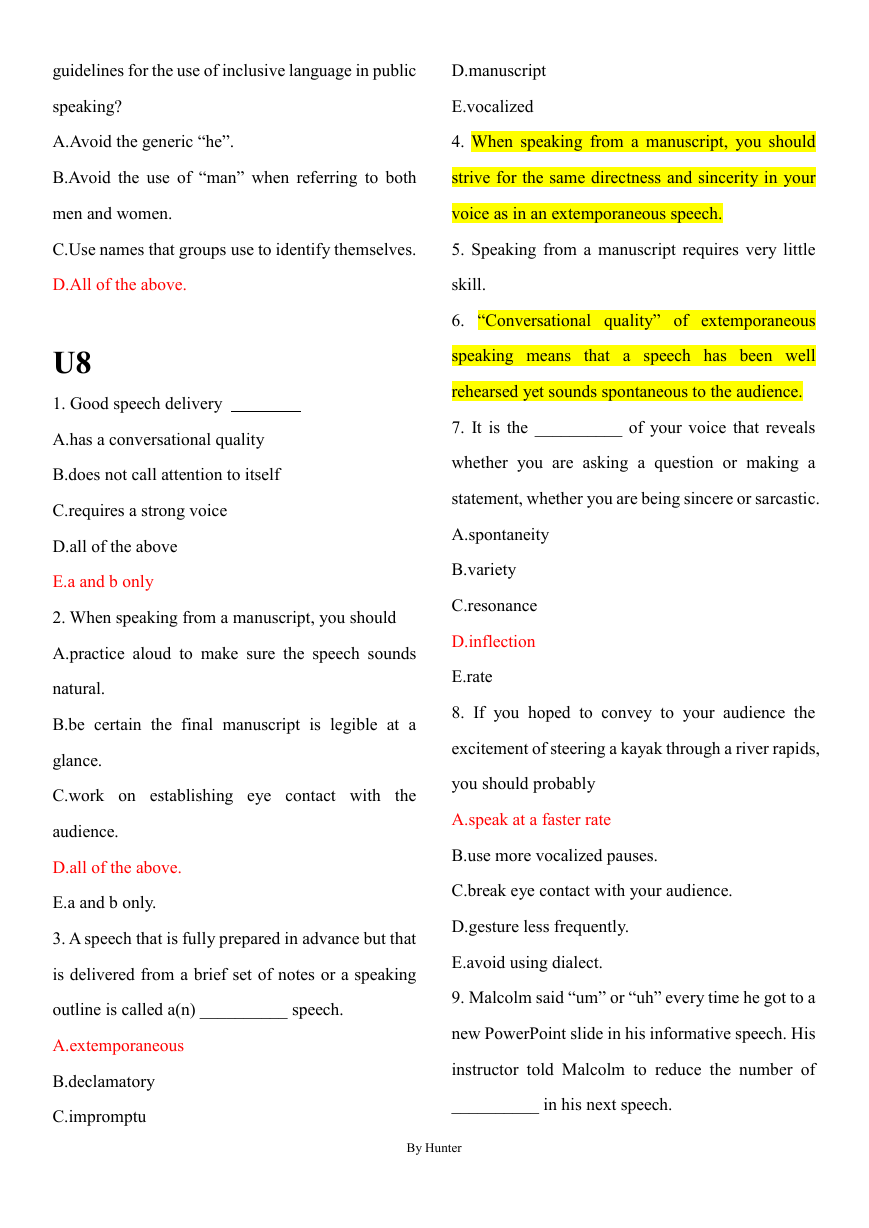
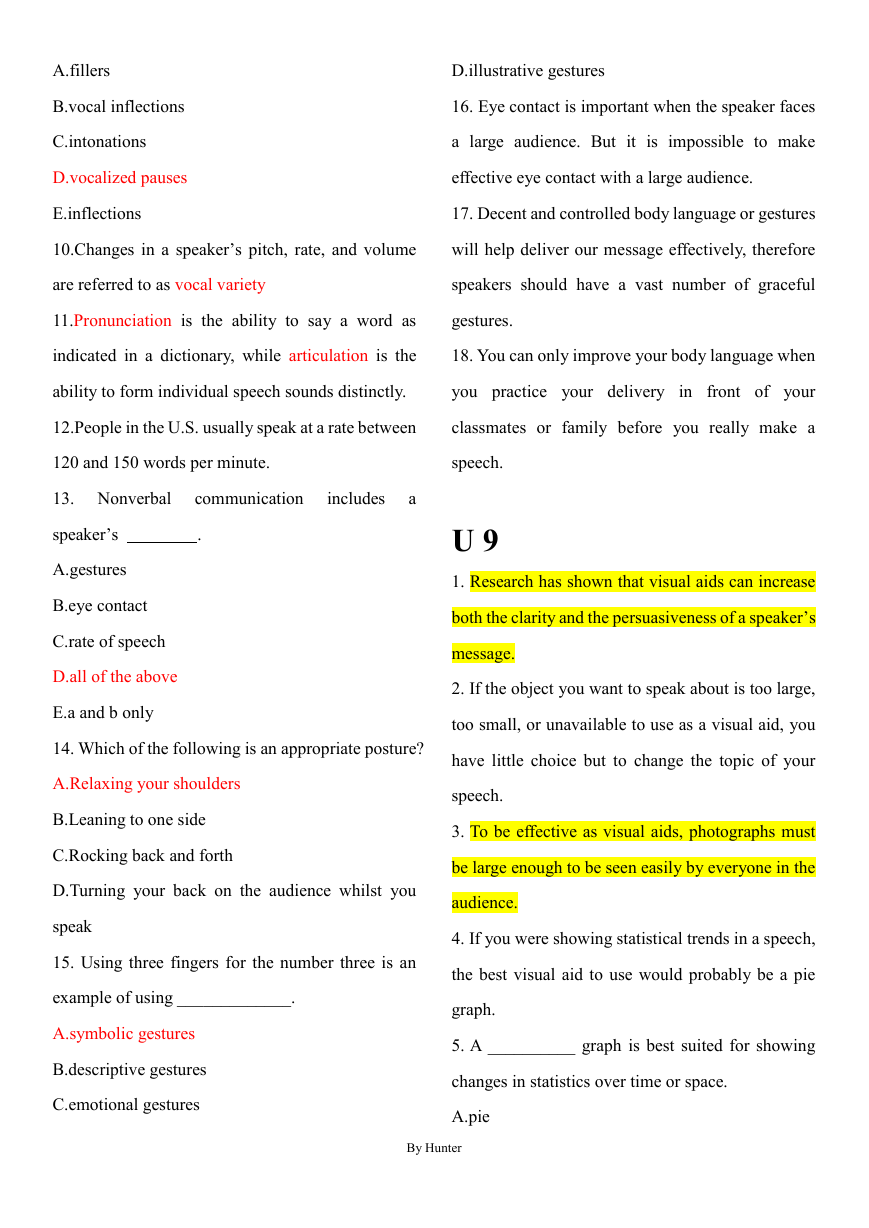
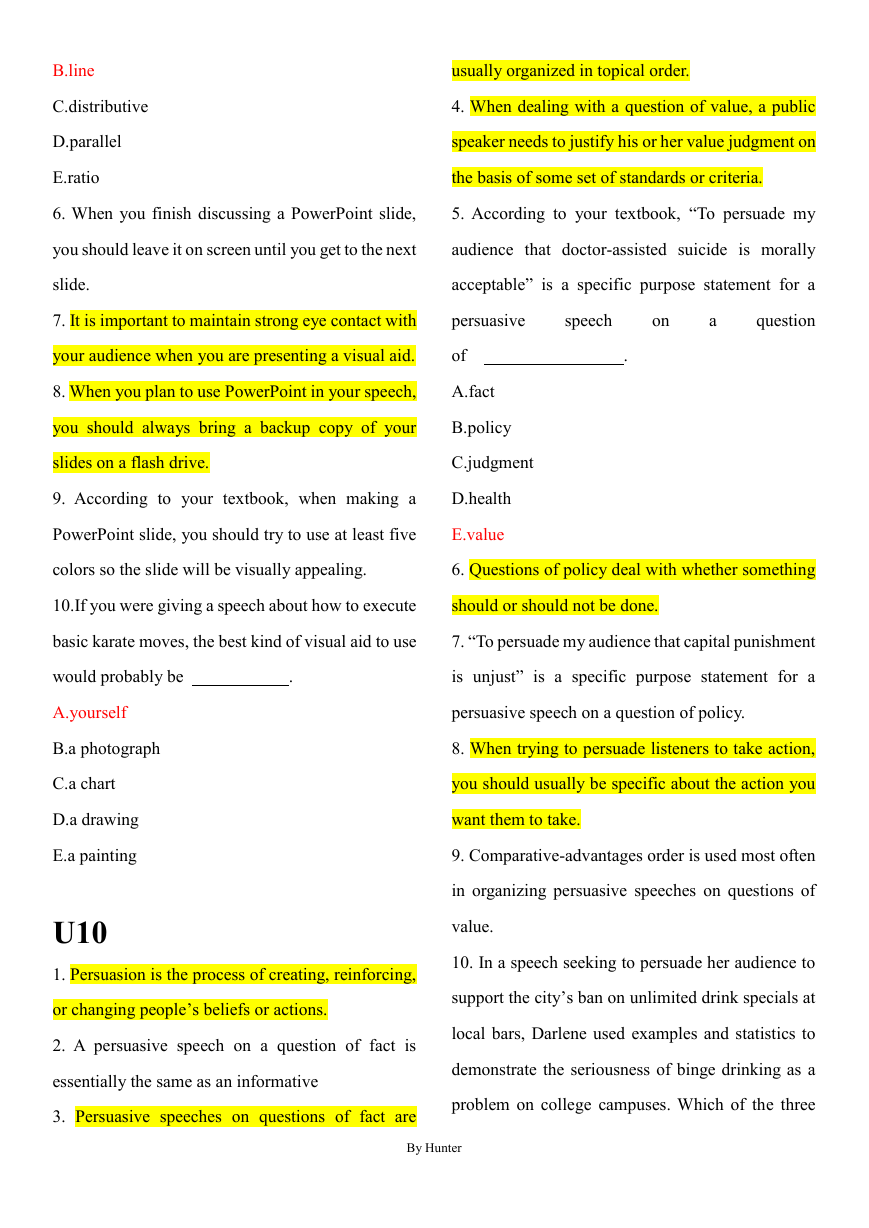
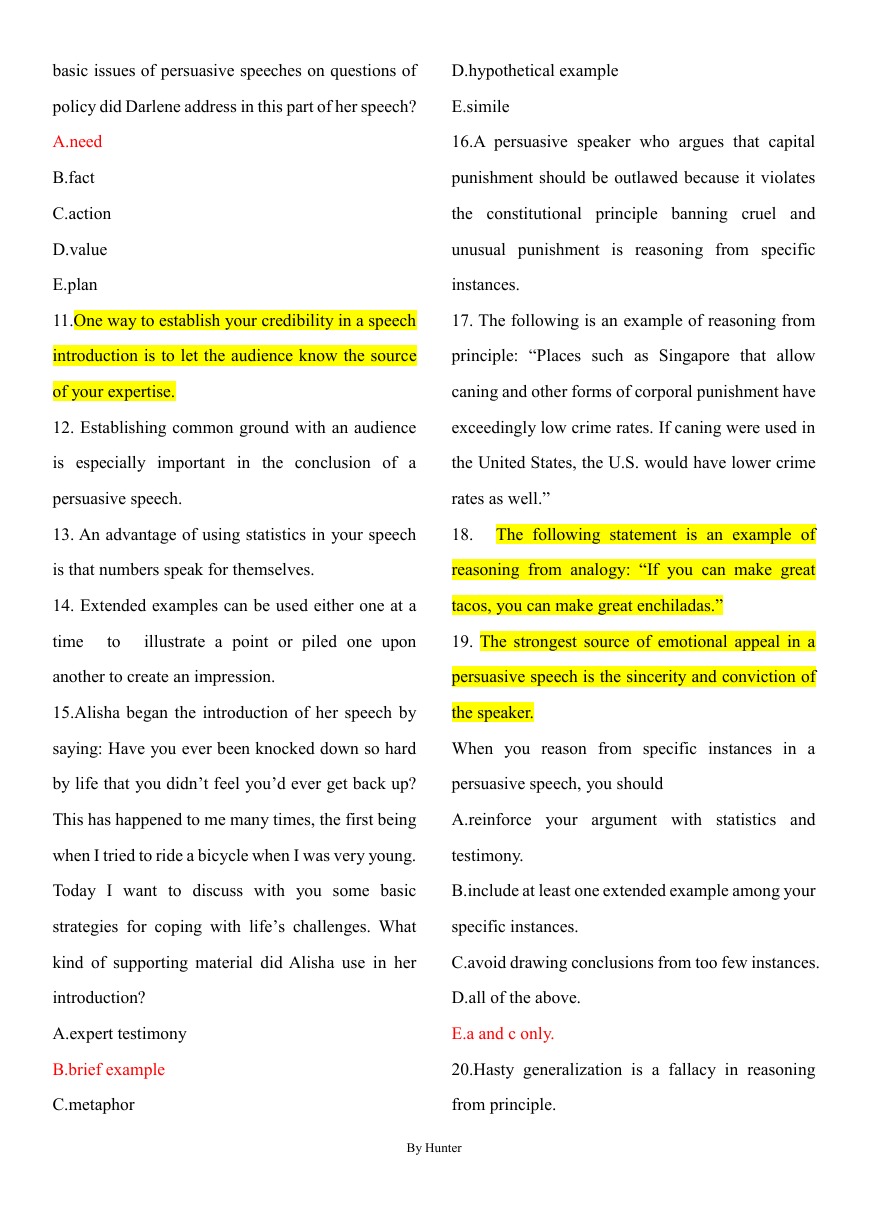







 2023年江西萍乡中考道德与法治真题及答案.doc
2023年江西萍乡中考道德与法治真题及答案.doc 2012年重庆南川中考生物真题及答案.doc
2012年重庆南川中考生物真题及答案.doc 2013年江西师范大学地理学综合及文艺理论基础考研真题.doc
2013年江西师范大学地理学综合及文艺理论基础考研真题.doc 2020年四川甘孜小升初语文真题及答案I卷.doc
2020年四川甘孜小升初语文真题及答案I卷.doc 2020年注册岩土工程师专业基础考试真题及答案.doc
2020年注册岩土工程师专业基础考试真题及答案.doc 2023-2024学年福建省厦门市九年级上学期数学月考试题及答案.doc
2023-2024学年福建省厦门市九年级上学期数学月考试题及答案.doc 2021-2022学年辽宁省沈阳市大东区九年级上学期语文期末试题及答案.doc
2021-2022学年辽宁省沈阳市大东区九年级上学期语文期末试题及答案.doc 2022-2023学年北京东城区初三第一学期物理期末试卷及答案.doc
2022-2023学年北京东城区初三第一学期物理期末试卷及答案.doc 2018上半年江西教师资格初中地理学科知识与教学能力真题及答案.doc
2018上半年江西教师资格初中地理学科知识与教学能力真题及答案.doc 2012年河北国家公务员申论考试真题及答案-省级.doc
2012年河北国家公务员申论考试真题及答案-省级.doc 2020-2021学年江苏省扬州市江都区邵樊片九年级上学期数学第一次质量检测试题及答案.doc
2020-2021学年江苏省扬州市江都区邵樊片九年级上学期数学第一次质量检测试题及答案.doc 2022下半年黑龙江教师资格证中学综合素质真题及答案.doc
2022下半年黑龙江教师资格证中学综合素质真题及答案.doc